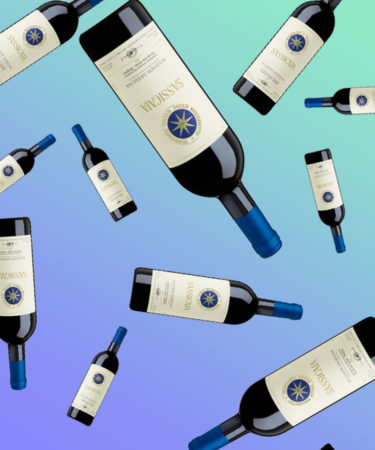When Marchese Mario Incisa della Rocchetta married Marchesa Clarice della Gherardesca in 1930, her dowry included the 7,500-acre Tenuta San Guido estate. Nowadays, the estate is better known by the name of its world-famous wine, Sassicaia.
Located in coastal Tuscany outside the village of Bolgheri, production in the region traditionally focused on light, easy-drinking wines, designed to be consumed shortly after harvest. But the Marchese had grander visions for the region’s winemaking potential. He dreamed of emulating fine Bordeaux reds, and aimed to craft wines that would rival the prestigious Chiantis of the nearby rolling Tuscan hills, and the Barolos of Piedmont in Italy’s northwest.
Della Rochetta saw his dreams realized in just a few decades. By the late 1970s, Tenuta San Guido’s Sassicaia helped spawn the highly coveted “Super Tuscan” category. Sassicaia’s widespread critical acclaim also caused ripples that would change Italian labeling laws forever.
How did one wine make such large waves? Here are 10 things you should know about Sassicaia.
-
Sassicaia shuns tradition.
In 1944, della Rocchetta planted the San Guido estate’s first vineyard, Castiglioncello, with Cabernet Sauvignon and Cabernet Franc. It was a bold, unconventional move. Italy’s finest wines traditionally featured native grapes such as Sangiovese and Nebbiolo, but the Marchese sought the “bouquet” of Bordeaux wines.
-
The first vintages failed to impress.
Up to the early 1960s, Tenuta San Guido didn’t release its wines commercially. And the unsophisticated early vintages failed to leave an impression on critics, who were more accustomed to the light, local style. The majority of production was instead consumed by the family or left forgotten in the cellar.
But when friends responded enthusiastically to a tasting of some of the estate’s older bottles in the 1960s, the Marchese continued his project with renewed vigor. In 1965, he planted a second vineyard, Sassicaia, from which he produced the first vintage in 1968. Tenuta San Guido released its first bottles to market in 1971.
-
The vineyard’s name is inspired by stones.
Located 650 feet below the Castiglioncello vineyard, Sassicaia is planted on a 30-acre plot of gravelly soil. Translating to “the place of many stones,” Sassicaia mirrors the Graves region of Bordeaux. (Graves also gains its name from its gravel-rich soils.)
-
Marchese’s son was just as innovative as his father.
During the late 1960s and early 1970s, Nicoló Incisa, the Marchese’s son, took an increasing role in wine production at the estate. Nicoló helped steer Tenuto San Guido to international acclaim by lowering vineyard yields and modernizing production methods. He also hired acclaimed winemaker Giacomo Tachis as a consultant.
-
French oak barriques bring balance.
Under the elder Marchese’s helm, the estate aged wines in 225-liter Slovenian oak barrels. The casks broke from the traditions of nearby Chianti, where large oak aging vats were commonplace. The highly extracted wines that emerged from the smaller barrels were hard and tannic. This character gave them great aging potential, but also meant the wines required extended periods to settle in bottle before they could shine.
Starting with the 1977 vintage, Tenuta San Guido introduced French Tronçais oak barriques (also 225 liters in capacity) for aging, which proved to strike the right balance and drastically improve quality at an earlier age.
-
Sassicaia is one of the original “Super Tuscan” wines.
In the 1970s, Tenuta San Guido wasn’t the only coastal Tuscan estate championing international grape varieties. Historic producer Marchesi Antinori introduced its Tignanello wine in 1971, under the direction of Nicoló’s cousin, Piero Antinori. And in 1981, Marchese Ludovico Antinori founded Tenuta dell’Ornellaia on the property neighboring Tenuta San Guido.
Along with a handful of other bottles, these wines spawned the now-world-famous “Super Tuscan” category. An unofficial term, the name refers to Tuscan wines that age in barriques and include (but are not limited to) Bordeaux varieties.
-
Sassicaia: the world’s best table wine.
Upon their introduction, the so-called Super Tuscans could only carry the labeling term Vino da Tavola, or table wine, because their grape varieties and barrel-aging practices fell outside of DOC and DOCG regulations.
Despite such lowly status, in 1978, a bottle of 1972 Sassicaia claimed top spot in a blind-tasting event against over 30 other Bordeaux blends from around the world. The victory gave the wine international recognition almost overnight.
-
Sassicaia’s victory prompted labeling reforms.
The fact that one of Italy’s finest wines could merely be labeled a table wine left the authorities in a quandary. Eventually, in 1992, they introduced the Indicazione Geografica Tipica (IGT) classification. Unlike DOC and DOCG classifications, the IGT classification focuses on the wine’s region of origin, rather than grape varieties or wine styles
Sassicaia’s prestige was further acknowledged in 1994, when the San Guido estate was awarded its own appellation, Bolgheri Sassicaia DOC. The broader Bolgheri region became an official DOC around this time.
-
Sassicaia is one of the most popular wines in the world.
According to Wine-Searcher.com search frequency data, Sassicaia is the world’s sixth most popular wine. The top 10 include many of the French producers that first inspired della Rocchetta, including Château Lafite Rothschild and Château Mouton Rothschild. It is the only Italian wine to hold a spot in the top 25.
-
Celebrities and athletes are fans.
Sassicaia’s legion of fans includes many high-profile admirers, including noted oenophile LeBron James as well as the Obamas, David Beckham, Rihanna, and Duran Duran. The latter reportedly requested the wine in their backstage rider for a 2011 world tour.
